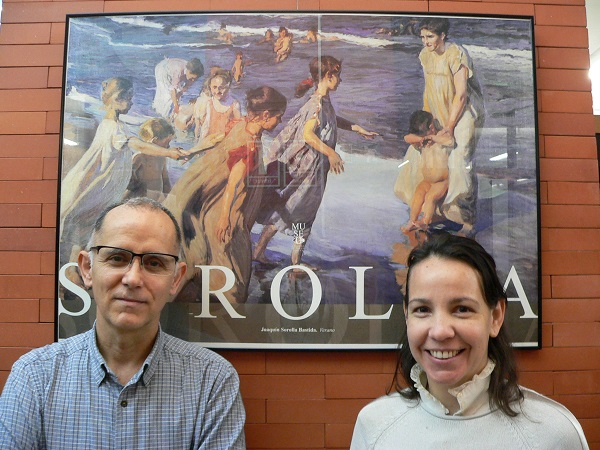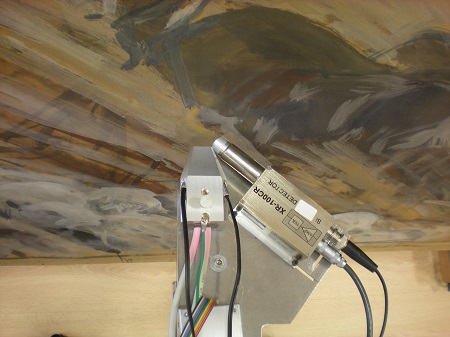
The first research realized until now about the goauche pigments used by the painter Joaquín Sorolla in the 32 preparatory sketches of “Visión de España” reveals that he used even twenty different pigments. The research, “Characterization of goauche pigments of Soroll by spectroscopy techniques” has been published in th e scientific magazine ”Radiation Physics and Chemistry”
The preparatory sketches of the serial “Visión de España” are an order realized by the patron Archer Milton Huntington on behalf of the Hispanic Society of New York, with the objective of showing a global vision of Spain, its lands and people, at the begging of the XX century. The sketches are a sample of rigour, implication and dedication of Joaquín Sorolla to the project.
The sketches, made with fast strokes, belong to characters, objects and landscapes that, afterwards, he cuts, resets and assembles in a kind of collage with which Sorolla experiments until he obtains the hoped composition. They are realized by gouache technique applied to paperbase (pictorial technique, similar to watercolour, made with colours diluted in water and whose results are opaquer layer with a higher coverage power).
The study of the sketches realized by the team leaded by Clodoaldo Roldán and in which has participated Jorgelina Carballo, researchers of the The Institute of Materials Science (ICMUV) of the Universitat de València, shows that gouache pigments were applied directly by Sorolla to the paperbase without turn to preparatory and priming layers. In the bases has been detected, moreover, the presence, in different proportions depending on the paper, of mineral charges (natural soil, compound of calcium and barite, that corresponded to inert materials added as solids to the paper to give more consistency or colour).
The palette of Sorolla in the sketches, emphasized Clodoaldo Roldán, is characterized by the systematic use of some pigments: white lead, pure or mixed with other pigments to obtain chromatic variations; vermilion in intense reds, carnation and salmon colours; blacks from bones or ivories in the folds of the clothes, shadows and contour lines; chromium green pigment in landscapes; ultramarine is skies; ochre yellow and soil pigments used in landscapes and carnations of people and animals.
Although, as the researcher team points, “the white zinc, yellow chrome and green colours from arsenical copper (Scheele’s green or emerald green) prevail in collages in figures cut and juxtapose in others”.
This is the first time a scientific study about gouache pigments used by Sorolla in the sketches of “Visión de España” is realized. With the research is hope to know analytic data useful to restoration and conservation works of these sketches. Conclusions have been obtained from 640 detailed analysis realized on the paperbase.
Analysis realized reveal that Sorolla used a varied range of pigments and have identify 20 different ones: whites (white lead, white zinc, lithopone); yellows (yellow ochre, yellow zinc, yellow chromium); blues (ultramarine, Prussian blue); browns (soils, oxides, ferrous hydroxide); blacks (black from bones, black based on coal); reds (vermilion, red ochre); greens (chrome oxide and/or viridian, Scheele’s green and/or emerald green, chrome green- chrome Prussian blue-,green soil).
Clodoaldo Roldán and Jorgelina Carballo emphasised that this work supposes a another step by the work of Joaquín Sorolla and provides a hole view of the palette of the Valencian artist to analysts, restorers, curators and art historians. Moreover, it provides a reference framework to the research of the pictures of the end of the century XIX and the beginning of the XX. “The results of this study provide a value information in the restoration process of the sketches carried out by the Conservation and Restoration Valencian Institute Cutur Arts (IVC+r)”, says Roldán.
Methods
The Institute of Material Science in the Universitat de València has realized two types about sketches analysis. On the one hand, non-destructive analysis through x-ray fluorescence which scattered in energy (EDXRF) to identify the elemental composition of the pigments, and preserving their integrity. On the other hand, it has been effected the analysis of microsamples with scanning electron microscopy (SEM) to study the structure of the pictorial technique of Sorolla.
This scientific study, “Characterization of Sorolla’s gouache pigments by means of spectroscopic techniques” complements physical-chemical analysis, previously realized by the ICMUV of the materials and techniques that Sorolla used in its artistic production at the beginning of the XX century. It is a period characterized by pictorial techniques and with new materials associated to the industrial expansion of synthetic pigments that flood the market along the XIX century.
Article:
Clodoaldo Roldán, David Juanes, Livio Ferrazza, Jorgelina Carballo: Characterization of Sorolla’s gouache pigments by means of spectroscopic techniques. Radiation Physics and Chemistry 119 (2016) 253–263.
http://dx.doi.org/10.1016/j.radphyschem.2015.11.009
Link:
http://www.sciencedirect.com/science/article/pii/S0969806X15300992
Images:










